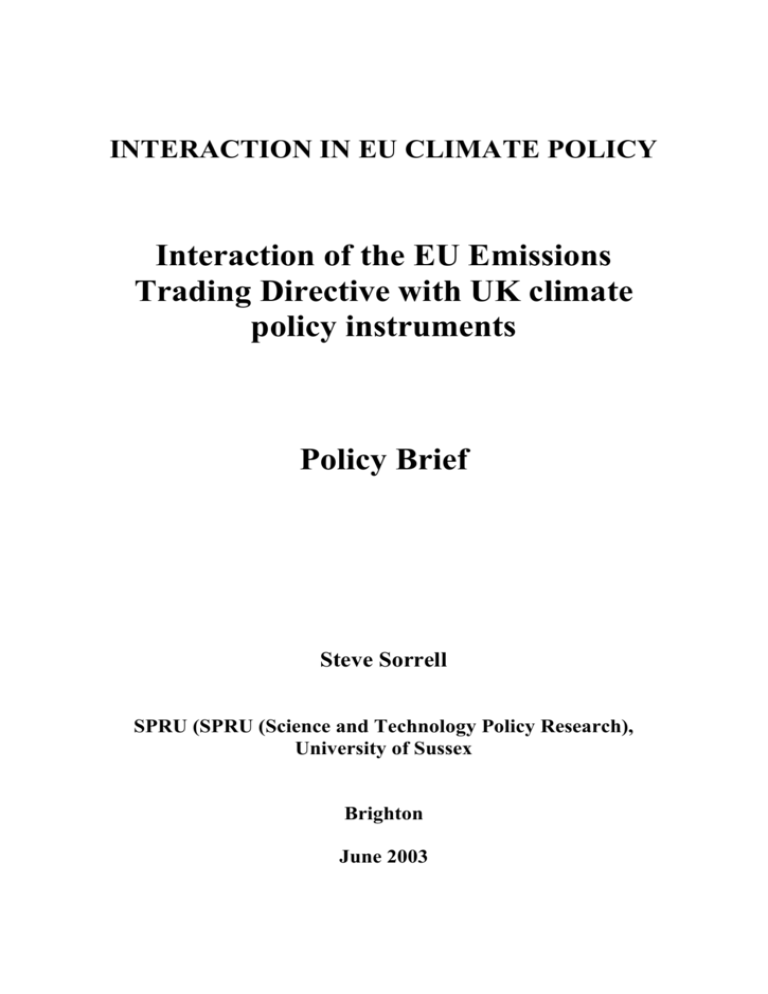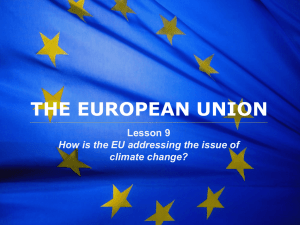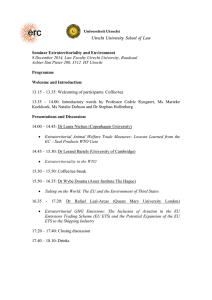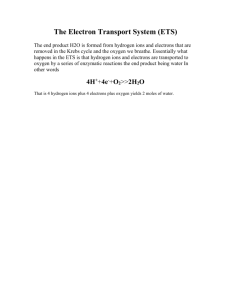Selected UK climate policy instruments
advertisement

INTERACTION IN EU CLIMATE POLICY Interaction of the EU Emissions Trading Directive with UK climate policy instruments Policy Brief Steve Sorrell SPRU (SPRU (Science and Technology Policy Research), University of Sussex Brighton June 2003 Introduction This brief provides an overview of the implications of the EU Emissions Trading Scheme (EU ETS) for selected instruments within UK climate policy. It summarises the results of research that has been conducted by SPRU as part of the EU-funded project Interaction in EU Climate Policy. The brief highlights a number of generic issues that are discussed in more detail in the overall project summary The Challenge of Policy Interaction. The UK provides a particularly rich and complex example of policy interaction. The UK has developed an elaborate and interdependent mix of climate policies, including a pilot emissions trading scheme which has received international attention. This policy mix is established and is delivering real emission reductions, but much of it is incompatible with the EU ETS. The introduction of the Directive may lead to significant changes to UK policy before 2005, and a major overhaul by 2008. None of this was anticipated when the UK Climate Programme was developed and the conflicts that result highlight some fundamental issues within policy design. Climate policy context The UK has been a strong supporter of the Kyoto Protocol and has played a proactive role in international negotiations. The UK’s target under the EU burden sharing agreement (-12.5%) is greater than the EU total (-8%) and the UK is one of the few Member States to be on course to meet its target. The relative ease with which the UK can meet its obligations has led it to take relatively little interest in the Kyoto mechanisms. In addition to the burden sharing target, the UK has a domestic ‘goal’ of reducing CO 2 emissions to 20% below 1990 levels by 2010. The attainment of this goal now looks less likely, owing to a range of factors such as higher energy demand by households and problems with transport policy. In an Energy White Paper published in March 2003, the government endorsed the recommendation from the Royal Commission on Environmental Pollution that the UK should put itself on a path towards a 60% reduction in CO2 emissions by 2050. While this is an important statement, the White Paper provided very little detail on new policies and mostly promised further rounds of consultation. The UK's proactive stance on climate change derives from a declining trend in emissions during the 1990s, with CO2 emissions in 2000 being some 8% less than in 1990. The bulk of these emission reductions result from the displacement of coal by gas in electricity generation and manufacturing. This large-scale fuel switching was driven by broader changes in the structure, governance, ownership and operation of the gas and electricity industries as a consequence of liberalisation. This process was facilitated in turn by low energy prices and the UK’s self-sufficiency in fossil fuels. Fuel switching has allowed environmental obligations to be met relatively easily, while consumers have benefited from substantial reductions in their energy bills. This period is now at an end. Concerns about energy security have revived as the UK shifts to becoming a net importer of oil and gas. While the liberalisation process focused on minimising the cost of operating inherited assets, the challenge now is to stimulate large-scale investment in replacement assets in the absence of long-term contracts. The market driven windfall in carbon emissions is over and the retirement of nuclear capacity is likely to create severe difficulties for meeting emission targets beyond 2010. With the recognition that a 60% target requires a transformation of the systems that deliver energy services, energy policy is firmly back on the UK policy agenda. The UK Programme for meeting its Kyoto obligations was introduced in November 2000. The Programme introduces a complex, elaborate and interdependent mix of policies that are intended to incentivise emission reductions across all sectors of the economy. These policies are designed to be consistent with other government objectives, notably shielding low income households from energy price increases. Most elements of the Programme are now operational, but the complexity of the policy mix has led to concerns over a ‘policy glut’ in the industrial sector. Also, the motivation to gain ‘first mover advantage’ in climate policy has led to difficulties as a result of subsequent incompatibilities with the EU ETS. Selected UK climate policy instruments A total of six UK policy instruments were selected for an examination of their potential interactions with the EU ETS. These were chosen on the basis of their relative importance and the extent to which they illustrate generic problems of policy interaction. The instruments are: Climate Change Levy (CCL): A downstream, revenue neutral energy tax for business and the public sector. Climate Change Agreements (CCAs): Negotiated agreements for energy intensive industry which give facilities exemption from 80% of the CCL. UK Emissions Trading Scheme (UK ETS): A voluntary, pilot trading scheme developed in collaboration with industry. Integrated Pollution Prevention and Control (IPPC): The UK implementation of the IPPC Directive, including provisions on energy efficiency. Renewables Obligation (RO): A tradable green credit scheme for renewable electricity, in which obligations to purchase renewable electricity are imposed upon electricity suppliers. Energy Efficiency Commitment (EEC): An obligation upon electricity suppliers to invest in energy efficiency in the household sector. The selected instruments are interlinked. For example, the CCAs provide exemption from CCL as well as forming part of the UK ETS. Similarly, there is trading interaction between the UK ETS, RO and EEC. The UK ETS itself is comprised of three elements: a) a voluntary cap & trade scheme, with participation incentivised by direct subsidy; b) a baseline and credit trading scheme for the CCAs; and c) a scheme for emission reduction projects. Table 1 lists these instruments and indicates the nature of their interaction with the EU ETS. Table 1 The nature of the potential interaction between selected UK policy instruments and the EU ETS Category Instrument Acronym Direct Indirect Trading Carbon/ energy Climate Change Levy taxes Negotiated Climate Change Agreements agreements Emissions trading UK Emissions Trading Scheme - cap & trade scheme Emissions trading UK Emissions Trading Scheme – project scheme Industrial Integrated Pollution Prevention pollution control and Control Directive Support for Renewables Obligation renewables Promotion of Energy Efficiency Commitment energy efficiency CCL CCAs UK ETS (DPs) UK ETS (projects) IPPC RO EEC Comprehensive analysis of the potential interactions between each of the above instruments and the EU ETS is provided in the INTERACT project reports for the UK (see further reading). The following two sections provide a summary of this analysis for two of the instruments – the CCL/CCA package and the UK ETS. In each case the scope, objectives, timing and operation of the instruments are compared, policy options are identified in the and specific policy recommendations are provided. Interaction between the EU ETS and the UK CCL/CCA package The CCL and CCAs need to be analysed together as they form a package. The CCL is a downstream, revenue-neutral energy tax for business and the public sector. It is levied on coal, gas and electricity use, with oil products, CHP fuel and renewable electricity being exempt. The indirect treatment of electricity was chosen to avoid electricity price increases for low income households, while an energy tax was chosen over a carbon tax to protect the UK coal industry. Both decisions have influenced the entire shape of the UK climate programme and have created serious compatibility problems with the EU ETS. The CCAs run until 2013 and give energy intensive industry exemption from 80% of the CCL, provided they take on binding targets for energy efficiency or carbon emissions. In practice, most sectors have adopted relative targets (e.g. energy use per unit of output), based upon a percentage of the estimated ‘cost effective’ energy efficiency potential. Targets are defined at two-year intervals up to 2010 and the penalty for failing to meet the targets is a return to paying 100% of the CCL. Eligible sites are those located in sectors which are regulated under IPPC and include many sites which lie below the IPPC size threshold. Both the CCL and the CCAs directly interact with the EUETS, and there is substantial indirect interaction in relation to electricity emissions. Since the CCAs incorporate baseline and credit trading arrangements as part of the UK ETS, there is also scope for trading interaction. Comparison of scope The scope of both the CCAs and the EU ETS is based on that of the IPPC Directive, but there are important differences at four levels: Sectoral coverage: Differences in the sectoral coverage of the CCL, CCAs, IPPC and EU ETS suggest that individual sites in the public, commercial, manufacturing and energy sectors may face one of ten combinations of the four instruments. Site coverage: Differences in the coverage of individual technologies within an individual site expands the number of possible combinations of instrument coverage from ten to eighteen. The differences relate to the coverage of combustion, process and ancillary plant and to the size of the main combustion plant. Emissions coverage: Further complications are introduced by the differences in coverage of CO2 versus other GHGs, combustion versus non-combustion CO2 emissions, and combustion emissions from different fossil fuels. Electricity coverage: A final layer of complexity is provided by the differing incentives each instrument creates for reducing emissions from electricity generation. Particular complications are introduced by the inconsistent treatment of electricity from various renewable sources. The net result is that introducing the EU ETS into the existing policy mix will entail administrative difficulties and raise complex issues of differential treatment and double regulation. Comparison of objectives The core objective of the CCL, CCAs and EU ETS is the same, but they differ in terms of their relative stringency and the importance they give to various subsidiary objectives. The stringency of the EU ETS is at present unclear and the proposed allocation criteria include both top-down and bottom up elements which are potentially contradictory. But there is a possibility that the targets required under the EU ETS will be more stringent than those currently applicable under the CCAs, quite apart from the fact that these will be absolute rather than relative targets. In addition, the possibility of purchasing ‘hot air’ allowances from the UK ETS provides a low cost route to CCA compliance. This has important implications for either the use of CCA targets as a basis for allocation in the EU ETS, or the use of opt-out provisions within the EU ETS at the sector or installation level. The design of the CCL/CCA package reflects multiple explicit and implicit objectives, including the desire to protect domestic consumers, energy intensive industry, and UK coal producers, together with promoting energy efficiency and avoiding a ‘windfall’ to nuclear generators. Each of these objectives is threatened by the introduction of the EU ETS. The Directive will disadvantage coal-fired electricity generation and accelerate its decline, raise electricity prices for household consumers, including the fuel poor, and improve the economics of nuclear power. Comparison of timing The EU ETS is in phase with the Kyoto commitment period, but is due to begin well before the CCAs end. In contrast, the CCAs extend beyond the end of the Kyoto commitment period, but targets are only negotiated up to 2010. The CCAs also include emissions trading provisions as part of the UK ETS, but at present this does not extend beyond 2006. The situation is simplified by the inclusion of opt-out provisions in the EU ETS, as these may allow many of the existing CCAs to continue unchanged up to 2008. But since opt-outs require demonstration of equivalence of effort, UK electricity generators and oil refineries will need to join the scheme in 2005 since these have no ‘equivalent’ regulations. The inclusion of the electricity generators creates a host of problems for the CCL/CCA package, as a consequence of the double regulation of electricity and double counting of electricity emissions. Furthermore, it is far from clear that retaining the existing CCAs can be considered equivalent to participating in the EU ETS, and the absence of opt-out provisions after 2008 makes it inevitable that the CCL/CCA package will be substantially changed well before the planned end date of the CCAs. Comparison of operation Coexistence of the EU ETS with an unchanged CCL/CCA package creates a range of double regulation problems, which raise overall abatement costs and potentially introduce distortions to competition. These problems would be eased if eligible CCAs opted-out of Phase 1, but this would still leave double regulation of electricity. Fossil-fuel electricity generators will pass a portion of allowance costs onto electricity consumers, many of which are either subject to the CCL or signatories to CCAs. The consequences of this will depend in part upon the allowance price in the EU ETS. High prices (from a stringent cap) could lead to substantial economic impacts for the affected groups, while low prices (from a weak cap) could have a relatively small impact. The impact of the EU ETS on electricity prices will also depend upon the carbon intensity of marginal generating plant on the system, which may be coal-fired for much of the year. If allowance costs are passed on in full to consumers, allowance prices as low as £5/tCO2 could increase average electricity prices by as much as the current level of the CCL. If both energy and allowance prices are low, there may be some appeal in retaining elements of the CCL/CCA package unchanged in order to maintain incentives to improve energy efficiency. This would reduce UK emissions and increase costs for UK participants, but the overall emissions covered by the EU ETS would be unchanged. Continuation of the CCL would also ensure that the revenue benefits of the tax are retained. In the absence of allowance auctioning, there is no revenue-neutral fiscal mechanism to compensate consumers for electricity price rises. Participants in the EU ETS could be compensated by allocating allowances in proportion to electricity consumption and requiring the generators to buy these back. But this would not help non-participants as these are not allowed to receive allowances. If allowance prices are high, industry groups may step up campaigning against the CCL. CCA facilities that have opted-out or are not eligible to join the EU ETS will face electricity price rises at the same time as having a target for their electricity consumption. This could lead to pressure to modify the CCAs so that (as with the EU ETS) they cover direct emissions only. But the UK government’s view is that price signals are less effective than downstream targets in incentivising electricity efficiency. If this is correct, such modifications would increase UK electricity consumption, although the total emissions covered by the EU ETS would remain unchanged. The participation of electricity generators in the EU ETS, combined with the continuation of the CCA trading provisions will lead to double counting of electricity emissions. These problems only result from increases above or reductions below the CCA targets and from changes in the emissions intensity of electricity use, which means that some emissions increases/reductions will be double counted and some not. Overall, this will not threaten the environmental integrity of either the EU ETS or the CCAs, but will introduce complexity into the policy mix as a result of a conflict over the compliance obligations for electricity emissions. The use of relative targets in the CCAs means that trading links with the EU ETS could inflate the number of EU ETS allowances and violate the EU ETS cap. Such problems could be avoided through the use of a ‘Gateway’ arrangement to prevent net sales from the CCA sector. Policy options There are a range of options for modifying the CCL/CCA package, nearly all of which offer an improvement on the coexistence scenario. The main options for eligible CCA facilities during Phase 1 are to: a) join the EU ETS and terminate the CCAs; b) join the EU ETS but retain CCA targets on electricity consumption; or c) opt-out of the EU ETS and continue with the CCAs. Eligible facilities appear most likely to choose the third option, but this still leaves a large number of non-eligible facilities continuing with their CCAs. These would face double regulation of electricity, as would non-CCA sites who continue to pay the CCL and EU ETS participants who continue with CCA targets on electricity. If double regulation proves unacceptable, the government could consider: first, modifying the CCL so that it applies to direct fuel use only; second, modifying the remaining CCAs so that they refer to direct emissions only; and third, dropping the electricity targets for EU ETS participants. There are benefits to be gained by going a step further and changing the CCL to a carbon tax and extending it to all downstream sectors and fuels. The main drawback is the loss of revenue, but this could be replaced through increasing the level of the tax. Opt-outs make the EU ETS more acceptable to industry and certain Member State governments, but the disadvantages include reducing the environmental effectiveness of the scheme and increasing administrative costs. Differential treatment via opt-outs could distort competition either between or within Member States, while equivalence of effort could prove difficult to demonstrate owing to substantial differences in the scope, form and stringency of the CCAs and EU ETS. Relative targets cannot be considered equivalent to absolute targets because they give no certainty in the environmental outcome and effectively act as a subsidy on production since they lead to higher emissions for the same level of marginal abatement cost. While a range of policy options are available, the basic choice is between, on the one hand, giving priority to economic efficiency by allowing the EU ETS to operate relatively unhindered; or on the other hand, giving priority to ‘supplementarity’ by retaining ‘backup’ regulations to incentivise domestic abatement. The choice may depend upon expectations regarding EU ETS allowance prices, but these are speculative and depend in part the interfaces between the EU ETS and the international carbon market after 2008. Recommendations the CCL should be removed from electricity, extended to all downstream sectors and fossil fuels and changed from a energy tax to a carbon tax; eligible installations should join the EU ETS and their existing CCA agreements should be terminated; CCA facilities not eligible for the EU ETS should renegotiate their agreements such that the targets relate to fuel consumption only; participants in the EU ETS should be exempt from the CCL; and they should be no trading interaction between the CCAs and EU ETS. 3. Interaction between the EU ETS and the UK ETS direct participant scheme The UK Emissions Trading Scheme (UK ETS) is a voluntary, pilot scheme, jointly developed by government and business, which began in January 2002 and is intended to run until 2006. The government is providing £43m/year over five years as an inducement for companies to join the scheme and to adopt absolute emission targets. Electricity generators are excluded since the scheme uses indirect treatment of electricity, and participants continue to pay the CCL. The UK ETS allows for three forms of participation: direct participants: voluntary participation in a cap and trade scheme, encouraged by the financial incentive; CCAs: baseline and credit trading by companies with a CCA; and projects: generation of credits from emission reduction projects in the UK. This section is confined to the direct participants,. There is a small degree of direct interaction between these and the installations eligible for the EU ETS, together with indirect interaction related to the treatment of electricity and the possibility of trading interaction. Comparison of scope Participation in the UK ETS is on a voluntary basis, subject to qualifying requirements. Thirty four companies have joined the scheme, securing annual emission reductions of 4MtCO2e by 2006, over half of which is from non-CO2 GHGs. Participants are from a diverse range of sectors and the nine largest companies are responsible for over 90% of the total reductions. There is very little overlap between the direct participants and the installations eligible for the EU ETS. This is because first, most of the direct participants are in sectors which are not eligible for the EU ETS; and second, of those participants which are eligible, the emission sources covered by the UK ETS are mostly different from those covered by the EU ETS. Exceptions include the non-combustion emissions from cement production and the emissions from >20MW combustion plant at direct participant sites which are not already covered by a CCA. In other words, there is potential double regulation of only a proportion of direct emissions at less than 10% of the direct participant sites. There is a more significant overlap in the emissions from electricity consumption at all the direct participant sites, since these are directly covered by the EU ETS and indirectly covered by the UK ETS. These emissions are subject to double regulation, with associated double counting. Comparison of objectives The UK ETS is both a voluntary scheme and a secondary element of the UKCP. In contrast, the EU ETS is intended to be mandatory and is considered essential for EU compliance with the Kyoto Protocol. The objectives in establishing a trading scheme are different for the UK and EU, in that the UK is well on course to meet its burden sharing target while the EU is heading for non-compliance. The UK ETS was intended to provide the UK with an early mover advantage in emissions trading, with benefits such as learning by doing, accelerating institutional developments such as the Registry, and enabling the City of London to become an international centre for emissions trading. Similar ‘soft’ benefits are expected from Phase 1 of the EU ETS, although the Directive has the additional objective of avoiding distortions to competition. While the experience with the UK ETS may facilitate the implementation of the EU ETS, the incompatibilities between the two has led the UK to negotiate opt-out provisions. This means that many UK companies could be excluded from EU-wide trading in Phase 1, or at best be subject to trading restrictions. Comparison of timing The first period of the UK ETS ends in December 2006, and at present the government has made no commitment to further incentivised rounds. There is therefore a two-year overlap between Phase 1 of the EU ETS and the UK ETS. Delays in introducing the EU ETS could reduce this to one year or zero, although in the latter case Phase 1 may be abandoned altogether. If the UK ETS ends in 2006 and if most direct participants are unable to join the EU ETS until 2008, the learning experience gained through the UK ETS will be undermined. Conversely, if the UK ETS continues beyond 2006, it will remain a limited and isolated scheme unless trading links can be established with the EU ETS. The large allowance surplus in the UK ETS suggests that allowances may be banked beyond 2006. If no trading links are established with the EU ETS, the value of these allowances will decline. Conversely, if the UK allows the banked allowances to be converted to AAUs, this could create an indirect link with the EU ETS and potentially threaten the UK’s compliance with its Kyoto obligations. Comparison of operation Coexistence of the UK ETS with the EU ETS leads to double regulation of a small proportion of the direct emissions from UK ETS participants, since these are covered by both schemes. As Phase 1 opt-outs are allowed, these sites could choose to remain in the UK ETS and retain their financial incentive but, since subsidised abatement is different from mandatory targets, there may be difficulties in demonstrating equivalence of effort. The attractions of opting-out will depend upon a range of factors, including the fungibility of UK ETS and EU ETS allowances. If these sites chose not to opt-out (or were unable to), they would need to join the EU ETS and relinquish their financial incentive and UK ETS responsibilities, with a consequent (limited) effect on the remaining UK ETS market. This option may also involve splitting these installations into EU ETS and residual UK ETS components. Coexistence of the two schemes also leads to double regulation of electricity for direct participants, analogous to that for the CCAs. Furthermore, since UK ETS participants continue to pay the CCL, there is effectively triple regulation of electricity at these sites. The economic consequences of this will depend upon trends in energy and allowance prices. Coexistence also leads to the double counting of emissions from electricity generation. Since total emissions will remain less than or equal to the sum of the allowance caps in the two schemes, overall environmental integrity will be maintained. Nevertheless, the dispute over compliance obligations creates a confused situation, which will be made worse if there are trading links between the two schemes. Policy options The primary options are, first, to allow direct participants to opt-in to the EU ETS, and second, to allow fungibility between UK ETS and EU ETS allowances. The advantages of opting-in include widening the scope of the EU ETS, increasing allowance supply, lowering allowance prices and bringing marginal abatement costs down (most direct participants would be net sellers). The disadvantages include increased administrative costs and the risk of injecting (possibly subsidised) hot air into the EU ETS. The motivation for opting-in is likely to be either low cost abatement through allowance purchase, or (more likely) higher prices for allowance sales. If the Commission wished to avoid double counting of electricity emissions, any opt-ins would need to be on the basis of direct emissions only. The incentive to opt-in to the EU ETS would also be increased if there were no fungibility between UK ETS and EU ETS allowances. The pros and cons of trading interaction between the EU ETS and UK ETS are complicated by the uncertainties over timing and the complex structure of the UK scheme. Table 2 provides a summary of some relevant issues. Taken together, these may be sufficient to prevent any links between the two schemes. The most likely outcome in practice is the prohibition of trading interaction and the postponement of opt-ins until Phase 2 of the scheme. Table 2 Factors influencing the fungibility of UK ETS and EU ETS allowances Factor Allocation method Absolute versus relative targets Coverage of GHGs Monitoring, reporting, verification Registry Compliance Banking Treatment of electricity Issues Direct participants have a competitive advantage through the financial incentive, but the majority do not compete with the sectors covered by the EU ETS. Also, the UK scheme was given state aid clearance and the relatively small number of direct participants may reduce equity concerns. To protect environmental integrity, a Gateway mechanism would be needed to govern trade between the CCAs with relative targets and the EU ETS. But no such restrictions are needed for trade with direct participants. The EU would need to approve the UK monitoring protocols. As with the financial incentive, allowing direct participants, but not EU ETS participants, to credit non-CO2 GHGs gives the former a competitive advantage. There may also be concerns regarding the potential ‘hot air’ associated with the non-CO2 GHGs in the UK scheme. The protocols should be broadly compatible in the two schemes The registries should be broadly compatible in the two schemes Statutory penalties are proposed for the UK scheme which are broadly equivalent to those in the EU ETS, while an additional incentive is provided by the resulting loss of the financial incentive. So this is unlikely to be an obstacle. Both schemes allow unrestricted banking prior to 2008. The UK scheme restricts banking beyond 2008, but this is consistent with the EU ETS proposals. There is a conflict over the ownership of a small proportion of the emissions from electricity generation, with consequent problems of double counting. The overall environmental integrity of the two schemes is not threatened, but the situation creates some confusion. Recommendations the UK direct participant scheme should cease in 2006, with no further incentivised rounds; trading between the direct participants and the EU ETS should not be allowed; further expansion of trading in the UK should be based upon opt-in provisions to the EU ETS (based on direct emissions only), together with sectoral expansion of the EU ETS; and restriction should be placed on the conversion of banked UK ETS allowances into AAUs. Policy implications The discussion in the previous two sections demonstrates that the implementation of the EU ETS in the UK raises some difficult questions in relation to double regulation, double counting, equivalence of effort, and the fungibility of trading commodities. Similar issues arise in relation to the other instruments listed in Table 1 and are described in detail in the INTERACT reports. These tensions highlights some key choices within UK climate policy, including: the choice of policy objectives for each instrument; the choice between upstream and downstream policy instruments; the choice to protect the domestic consumer; and the choice to prioritise domestic abatement. The choice of policy objectives In a cap & trade scheme, the total volume of emission reduction is set by the cap. Hence, any instrument that directly or indirectly interacts with the EU ETS will contribute nothing further to overall emission reductions. Furthermore, assuming perfect allowance and product markets, it will also raise the overall costs of meeting the cap. Hence, once the EU ETS is in place, such instruments can no longer be justified through their contribution to emission reductions. Instead, alternative rationales must be provided such as their contribution to nonefficiency objectives or to overcoming market failures other than externalities. This makes the specification of policy objectives for each instrument all the more important. For example, support for renewables technology could be justified in relation to technology market failures but not in relation to the contribution of renewables to emission reductions. If objectives are clear, the costs, benefits and trade-offs can be made explicit. But the existing UK policy mix has instruments with multiple explicit and implicit objectives - in which priority is given to emission reductions - and with varying degrees of transparency and rationality. The choice instruments between upstream and downstream The EU ETS is a downstream scheme in which obligations are placed directly on fossil fuel users rather than indirectly on fossil fuel producers. Similarly, the EU ETS places obligations directly on electricity generators, rather than indirectly on electricity consumers. While there are pros and cons to each approach, the EU ETS has constrained future UK policy by making these choices. The UK cannot now introduce either an upstream carbon/energy tax or downstream instruments for electricity consumers without this leading to double regulation. This does not mean that such options are ruled out, but merely that the justification for such options must pay close attention to trade-offs between policy objectives and the consequences of policy interactions. For example, an upstream carbon/energy tax may be justified through the capture of windfall rent from allowance allocation or the maintenance of fiscal revenue, but this must be traded off against the resulting distortions in substitution incentives. The choice to protect the domestic consumer Most of the incompatibilities between the EU ETS and UK climate policy stem from the differing treatment of electricity. And, the primary reason for this difference lies in the decision to protect low income households from increases in electricity prices. Since all households have been shielded from price rises in order to protect this vulnerable group, the UK government has created a fundamental tension between climate and social policy in this sector. The EU ETS makes this tension explicit and undermines the government’s social policy objectives. It follows that the elimination of ‘fuel poverty’ is necessary both to curb emissions from the domestic sector and to rationalise climate policy for other sectors. A better approach would be to extend the CCL to the domestic sector whilst compensating fuel poor households directly. The choice to prioritise domestic abatement There is a tension between the UK's target of a 20% reduction in CO2 emissions and the flexibility offered by International Emissions Trading (IET). If the UK achieved this target and either banked or sold the surplus AAUs, the environmental rationale for the target would be undermined. Conversely, a decision to ‘retire’ the AAUs would entail substantial opportunity costs. Under IET, this decision rests with the UK government. But under the EU ETS, decision rights for approximately one half of UK CO2 emissions are allocated to private sector actors who can choose to trade allowances with other Member States. A decision to base the UK allocation under the EU ETS on the 20% target would not necessarily help in attaining this target because UK participants could simply purchase additional allowances (although it would increase the stringency of the overall EU cap). Instead, the only way to ensure that the emissions of UK participants are consistent with the 20% target would be to introduce additional ‘backup’ regulations that directly or indirectly affected their emissions. This in turn would distort the operation of the EU ETS, raise costs for UK participants, lower allowance prices and potentially introduce distortions to competition. Conclusions The EU ETS presents a major challenge to UK climate policy and highlights issues that lie the heart of the climate debate. These include the status of the 20% target, the appropriate treatment of electricity and the priority to be given to tackling fuel poverty. Both government and stakeholders have been slow in recognising this, but a vigorous debate is now underway. In the long-term, it is clear that the EU ETS will trigger major changes in UK climate policy. If the transition is handled well, the final result should be a rationalised policy mix which offers advantages in terms of both efficiency and equity. If it is not handled well, the final result could be a policy mess. Further Reading Sorrell, S. (2002), The Climate Confusion: Implications of the EU Emissions Trading Scheme for the UK Climate Change Levy and Climate Change Agreements, SPRU (Science and Technology Policy), University Of Sussex, Brighton, Available from: http://www.sussex.ac.uk/spru/environment/research/ccfr.pdf Sorrell, S. (2003), Back to the Drawing Board: Implications of the EU Emissions Trading Scheme for UK Climate Policy, SPRU (Science and Technology Policy), University Of Sussex, Brighton, Available from: http://www.sussex.ac.uk/spru/environment/research/drawingreport.pdf. Sorrell, S. and J. Sijm (2003), ‘Carbon trading in the policy mix’, Oxford Review of Economic Policy, forthcoming October 2003. Sorrell, S. (2003), ‘Turning an early start into a false start: implications of the EU Emissions Trading Directive for the UK Climate Change Levy and Climate Change Agreements’, Paper for the OECD Global Forum On Sustainable Development: Emissions Trading, 1718 March 2003, Paris, available from: http://www.oecd.org/pdf/M00042000/M00042062.pdf. Sorrell, S. (2003), ‘Who owns the carbon? interactions between the EU emissions trading scheme and the UK Renewables Obligation and Energy Efficiency Commitment’, Energy and Environment, forthcoming July 2003. Boemare, C., P. Quirion and Sorrell, S. (2003), ‘Tensions between national trading schemes in Europe and the proposed EU Directive – a comparison between the UK and France’, Climate Policy, forthcoming 2003.







